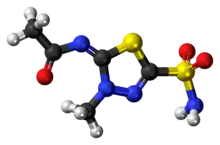 | |
 | |
| Clinical data | |
|---|---|
| Other names | N-(3-Methyl-5-sulfamoyl-3H-1,3,4-thiadiazol-2-ylidene) ethanamide |
| AHFS/Drugs.com | Monograph |
| MedlinePlus | a601233 |
| Routes of administration | Oral |
| ATC code | |
| Legal status | |
| Legal status |
|
| Pharmacokinetic data | |
| Protein binding | ~55% |
| Elimination half-life | ~14 hours |
| Identifiers | |
| |
| CAS Number | |
| PubChem CID | |
| IUPHAR/BPS | |
| DrugBank | |
| ChemSpider | |
| UNII | |
| KEGG | |
| ChEMBL | |
| CompTox Dashboard (EPA) | |
| ECHA InfoCard | 100.008.243 |
| Chemical and physical data | |
| Formula | C5H8N4O3S2 |
| Molar mass | 236.26 g·mol−1 |
| 3D model (JSmol) | |
| |
| |
| | |
Methazolamide (trade name Neptazane) is a potent carbonic anhydrase inhibitor. It is indicated in the treatment of increased intraocular pressure (IOP) in chronic open-angle glaucoma and secondary glaucoma. Also it is used preoperatively in acute angle-closure (narrow-angle) glaucoma where lowering the IOP is desired before surgery.
This drug has displayed teratogenic effects in rats. Compared to another drug in the same class, acetazolamide, methazolamide requires a lower dose when administered to patients.
References
- Iyer G, Bellantone R, Taft D (1999). "In vitro characterization of the erythrocyte distribution of methazolamide: a model of erythrocyte transport and binding kinetics". J Pharmacokinet Biopharm. 27 (1): 45–66. doi:10.1023/A:1020630712388. PMID 10533697. S2CID 24294348.
- RxList. "Neptazane". Archived from the original on August 12, 2006. Retrieved August 20, 2006.
- Shirato S, Kagaya F, Suzuki Y, Joukou S (1997). "Stevens–Johnson syndrome induced by methazolamide treatment". Arch Ophthalmol. 115 (4): 550–3. doi:10.1001/archopht.1997.01100150552021. PMID 9109770.
- Skorobohach B, Ward D, Hendrix D (2003). "Effects of oral administration of methazolamide on intraocular pressure and aqueous humor flow rate in clinically normal dogs". Am J Vet Res. 64 (2): 183–7. doi:10.2460/ajvr.2003.64.183. PMID 12602587.
This article is issued from Wikipedia. The text is licensed under Creative Commons - Attribution - Sharealike. Additional terms may apply for the media files.